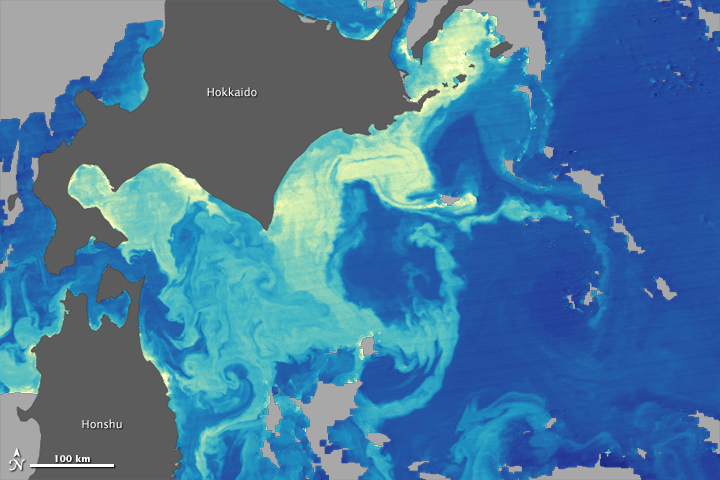NASA: Japan sea area - Spring Greening Around Hokkaido - 11.04.13
Posted by Ricardo Marcenaro | Posted in NASA: Japan sea area - Spring Greening Around Hokkaido - 11.04.13 | Posted on 14:44

acquired March 27, 2013
download large image (604 KB, JPEG, 1000x1000)
acquired March 27, 2013
download GeoTIFF file (4 MB, TIFF)
acquired March 27, 2013
download Google Earth file (KML)
Springtime in the northern hemisphere
brings green buds and sprouts to plants on land. It also brings blooms
in the seas, where increasing sunlight and nutrient-rich waters promote
the growth of phytoplankton. These microscopic, plant-like organisms use
chlorophyll
to harness energy from the Sun and fuel their own growth. They are the
center of the ocean food web, as everything from zooplankton to fish to
whales consume phytoplankton.
Off the coast of Japan’s Hokkaido and Honshu islands in late March 2013, the seas were enriched with the chlorophyll of blooming phytoplankton. The pigments were detected by the Moderate Resolution Imaging Spectroradiometer (MODIS) on NASA’s Aqua on March 27, 2013.
The image above shows chlorophyll concentrations in milligrams per cubic meter of water. Blue indicates areas with low concentrations of chlorophyll, and shades of yellow indicate high concentrations. Land is dark gray, while light gray areas depict where MODIS could not collect data due to clouds blocking the sensor’s view.
Blooms off the coast of Hokkaido are a yearly springtime occurrence, supporting one of the most productive fisheries in the world. The cool, nutrient-rich Oyashio Current arises in Arctic waters, flows south and west along the coast of Siberia and Kamchatka, and then turns east around Hokkaido. In springtime, the coastal waters off of the island as well as the incoming Oyashio Current are both enriched with iron, a critical nutrient for phytoplankton growth. Later in the spring and summer, the interaction of the Oyashio with the northeast-flowing Kuroshio Current can provoke eddies that stir up nutrients from deeper waters, fueling more blooms.
Off the coast of Japan’s Hokkaido and Honshu islands in late March 2013, the seas were enriched with the chlorophyll of blooming phytoplankton. The pigments were detected by the Moderate Resolution Imaging Spectroradiometer (MODIS) on NASA’s Aqua on March 27, 2013.
The image above shows chlorophyll concentrations in milligrams per cubic meter of water. Blue indicates areas with low concentrations of chlorophyll, and shades of yellow indicate high concentrations. Land is dark gray, while light gray areas depict where MODIS could not collect data due to clouds blocking the sensor’s view.
Blooms off the coast of Hokkaido are a yearly springtime occurrence, supporting one of the most productive fisheries in the world. The cool, nutrient-rich Oyashio Current arises in Arctic waters, flows south and west along the coast of Siberia and Kamchatka, and then turns east around Hokkaido. In springtime, the coastal waters off of the island as well as the incoming Oyashio Current are both enriched with iron, a critical nutrient for phytoplankton growth. Later in the spring and summer, the interaction of the Oyashio with the northeast-flowing Kuroshio Current can provoke eddies that stir up nutrients from deeper waters, fueling more blooms.
-
Further Reading
- Kasai, H. et al (1997) Variability in timing and magnitude of spring bloom in the Oyashio region, the western subarctic Pacific off Hokkaido, Japan. Fisheries Oceanography, 6 (2) 118–129.
- Nakayama, Y. et al (2010) Temporal variability and bioavailability of iron and other nutrients during the spring phytoplankton bloom in the Oyashio region. Deep Sea Research Part II: Topical Studies in Oceanography, 57 (17-18) 1618–1629.
- NASA Earth Observatory (2009, June 11) Spring Bloom Colors the Pacific Near Hokkaido.
- NASA Earth Observatory Global Maps: Chlorophyll.
NASA Earth Observatory image by Jesse Allen, using data from the Ocean Color Web. Caption by Michael Carlowicz
- Instrument:
- Aqua - MODIS
NASA: Japan sea area - Spring Greening Around Hokkaido - 11.04.13


Comments (0)
Publicar un comentario